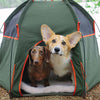How Do You Walk A Dog
Posted by Michael Shine
Learn to walk a dog early in your relationship to make your walks more enjoyable for both you and your dog. Use a front clip harness; this will prevent the dog from choking. Don't stop your dog from sniffing, they will do this for mental stimulation, and they will do it often.
Use a traditional leash that is nonretractable for your dog walks. Bring an ample supply of water and ALWAYS, please pick up after your dogs, no one likes getting poop on their shoes. Now that you know the basics, let's dive deeper into how do you walk a dog.
Dog walks are essential for the proper growth of your puppy. Walking on a leash teaches your dog you are in charge, do not harshly use a rope, we will explain better ways for training your dog. You should walk your dog at least once every day; we should at least shoot for every other day if every day is not possible. Remember, you are getting the same exercise as your dog, so why not.
Hydration, Water and a Healthy Dog
Before even thinking of going for a walk, water should be the first thing on your mind. Carry plenty of water and food. Along with poop bags, carry a portable bowl and a bottle of water for your pet. Keeping your dog hydrated is essential when walking for more extended periods or during the hotter times of the day.
During the summer months, it is extra important that your dog has plenty of water. Your pet's hydration is the essential part of dog walking that some people often overlook.
Food to Keep Your Dog Focused
Your dog learns by repetition; providing a treat or a particular food after or during your walk will trigger a memory in your pet's brain telling them, if I do this, I will get that special treat. Dogs with behavior problems will take more training and attention. If you can teach your dog to sit, loose leash walking will be no problem.
Protect Your Pooch's Paws Properly
Say that three times fast, I know you did. Your pet doesn't enjoy wearing the latest Nikes or Converse on those scorching days. Do you want to know if the pavement is too hot for your dog? Place the back of your hand or barefoot on the asphalt for a couple of seconds. If it's too hot for your skin, it's too hot for your dogs' feet.
Warning! Hot Pavement Can Cause Burns | disclosure. We just added that in case you did not know, you can burn yourself on the scorching pavement. Be careful is the lesson here.
Use a Dog Harness, and Never a Choker
Introduce him to the collar or harness and leash. Dog leashes come in all kinds of designs, colors, and lengths, make sure to use a size chart to get the size for your dog. Teach a cue. Make him come to you. If your dog starts pulling in the other direction, turn yourself into "a statue." Do not give in to your dog, or he or she will continue to draw you around and never learn to walk in the future appropriately. A statue doesn't move, so when your dog pulls, stand firm.
Practice inside. Take it outside. When you feel comfortable walking around your place, introduce your pet to new experiences and locations. Bring new "dog friends" over for "pet dates" and enjoy your time together or take a break and let your dog enjoy there time. A leash and harness are not painful if you follow some simple rules.
Put a leash and harness on the dog. Keep the harness tight, but not too tight. Choose the side on which you want your dog to walk. Pull the leash close to your body. Talk to your dog. Reward your dog with special treats and never harm your pet with a choking device.
You can use a collar to walk your pet, but always be careful when you or they stop walking or runs off to chase a squirrel. You do not want to choke your pet in any way. Pulling your dog's neck in a strong force could cause lasting harm.
Dog Collars and Id Tags
Make sure your dog is wearing proper identification every time you leave the house with your dog to ensure that they're wearing ID tags. Pet ID tags come in many shapes and sizes and also provide the options to have your information engraved on them. Unfortunately, you can't control everything that happens, and sometimes dogs get lost — sad face.
Be prepared by making sure your dog is wearing tags that are up to date. You can write on the inside of the collar with a sharpie of your information. It is an extra precaution, to pet tag malfunction. And since collars can break or wiggle out of, talk to your veterinarian about getting a microchip. The microchip will store the dogs' id tags in a universal database that helps to track your dog down much more accessible than visiting every animal shelter in town.
Have Fun, Talk to Your Dog
Your dog understands the tone in your voice. Don't get frustrated. Encourage your dog with a "what a good boy/girl" or "who is the best dog, you are, that's who" when it does something right. Use a STERN voice when instructing it not to do the wrong things, like pulling too hard on the leash to force control, barking at people passing by, or growling at other dogs.
Use this time to train and love your pup at the same time. If you are both having fun, soon you will be the top walkers of the neighborhood.
 5 Star Customer Reviews
5 Star Customer Reviews FREE Shipping Over $39
FREE Shipping Over $39
 Exceptional Customer Care
Exceptional Customer Care





